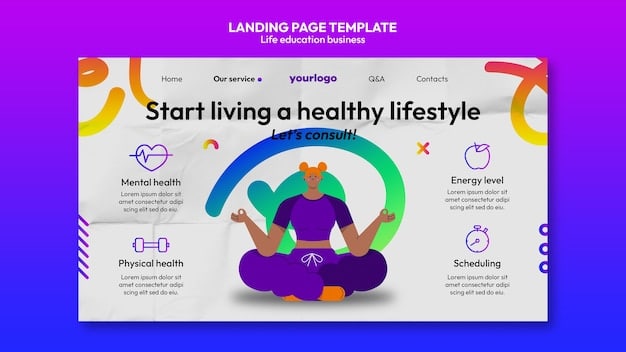Reduce Your Burnout Risk: 5 Strategies for Workplace Stress

Advertisements
Stress and burnout are pervasive issues in today’s demanding work environments, but implementing proactive strategies such as prioritizing self-care, setting clear boundaries, fostering supportive relationships, developing coping mechanisms, and seeking professional help can significantly diminish their impact and enhance overall well-being.
In the demanding landscape of modern professional life, the shadow of burnout looms large, threatening productivity, well-being, and overall job satisfaction. Learning to reduce your risk of burnout: 5 practical strategies for managing workplace stress is no longer just a luxury; it’s an essential skill set for sustainable career longevity and personal health. This comprehensive guide delves into actionable methods designed to empower individuals in the workplace, fostering resilience against the relentless pressures of everyday work.
understanding burnout and its silent progression
Burnout, often mistakenly equated with mere stress, represents a chronic state of emotional, physical, and mental exhaustion caused by excessive and prolonged stress. It’s a syndrome conceptualized by the World Health Organization (WHO) stemming from unmanaged chronic workplace stress, characterized by feelings of energy depletion or exhaustion, increased mental distance from one’s job, or feelings of negativism or cynicism related to one’s job, and reduced professional efficacy.
The progression of burnout is insidious, often starting with subtle signs that are easily overlooked or dismissed. Initially, individuals might experience mild fatigue or a decreased sense of accomplishment. Over time, these symptoms can escalate, leading to significant emotional detachment, pervasive cynicism, and a profound sense of inefficiency. Recognizing these early warning signs is crucial for intervention before burnout becomes deeply entrenched.
the insidious nature of workplace stress
Workplace stress manifests in various forms, from tight deadlines and heavy workloads to difficult interpersonal dynamics and lack of control over one’s tasks. Chronic exposure to these stressors without adequate coping mechanisms or organizational support paves the way for burnout.
- Constant pressure: The never-ending demand for higher productivity and faster results.
- Lack of control: Feeling powerless over one’s work processes, schedules, or outcomes.
- Insufficient rewards: A perceived imbalance between effort exerted and recognition received, whether financial, professional, or personal.
- Breakdown of community: Isolation or lack of supportive relationships within the workplace.
These elements combine to create an environment ripe for the development of burnout. Understanding the difference between acute stress, which can be motivating, and chronic stress, which erodes well-being, is fundamental. Burnout signifies that the body and mind have reached their breaking point under sustained pressure.
distinguishing between stress and burnout
While often used interchangeably, stress and burnout are distinct. Stress is characterized by over-engagement, where individuals feel a sense of urgency and hyperactivity. Burnout, conversely, is marked by disengagement, feelings of helplessness, and hopelessness. Stress can be acute or chronic, but burnout is always a consequence of prolonged, unmanaged stress.
For example, a person under stress might work long hours with determination, driven by adrenaline to meet a deadline. A person experiencing burnout, however, might also work long hours but with a sense of apathy, detachment, and profound fatigue, finding it difficult to muster any enthusiasm or mental clarity.
Recognizing the distinct nature of these conditions is the first step toward effective management and prevention. It enables a more targeted approach to interventions, moving beyond simple stress relief techniques to comprehensive strategies for burnout recovery and resilience building.
strategy 1: prioritize self-care as a non-negotiable
Self-care is not a luxury; it is a fundamental need, especially for those navigating high-stress work environments. It involves consciously taking steps to attend to your physical, emotional, and mental health, viewing these actions as preventative measures against depletion rather than reactive responses to distress. Integrating self-care into your daily routine is a cornerstone of preventing burnout.
True self-care goes beyond superficial acts. It encompasses a holistic approach to well-being, recognizing that all aspects of your health are interconnected. Neglecting one area can have ripple effects across the others, contributing to a cumulative burden that fuels burnout.

creating a personalized self-care toolkit
What constitutes effective self-care is highly individual. A personalized toolkit means identifying activities and practices that genuinely replenish your energy and soothe your mind. This is not about adding more items to an already full to-do list but rather about strategically carving out time and space for activities that nourish you.
- Adequate sleep: Prioritizing 7-9 hours of quality sleep per night is crucial for physical and cognitive restoration. Establish a consistent sleep schedule and create a relaxing bedtime routine to optimize your sleep hygiene.
- Nutritious eating: Fueling your body with balanced meals helps maintain energy levels and mood stability. Avoid excessive caffeine and sugary snacks that can lead to energy crashes.
- Regular physical activity: Exercise is a potent stress reliever, releasing endorphins that improve mood and reduce tension. Even short walks can make a significant difference.
- Mindfulness and meditation: Practices like mindfulness or meditation can help ground you in the present moment, reducing rumination and anxiety. Apps and guided meditations can make this accessible.
The goal is to cultivate a repertoire of self-care practices that you can consistently draw upon, adapting them as your needs evolve. This proactive approach ensures that you are continuously building your emotional and physical reserves, making you more resilient to workplace pressures.
setting boundaries for self-preservation
Effective self-care also involves setting firm boundaries between your work life and personal life. In today’s hyper-connected world, the lines often blur, with work bleeding into evenings, weekends, and holidays. Establishing clear boundaries protects your personal time, allowing for genuine rest and rejuvenation.
This includes practices such as turning off work notifications after hours, refraining from checking emails during personal time, and clearly communicating your availability to colleagues and superiors. While challenging, especially in cultures that glorify overwork, these boundaries are vital for maintaining mental health and preventing chronic exhaustion.
Ultimately, prioritizing self-care is an act of self-preservation. It is a commitment to your long-term health and professional sustainability, recognizing that you cannot pour from an empty cup. By consistently nurturing yourself, you build the foundation necessary to manage workplace stress effectively and reduce the likelihood of burnout.
strategy 2: set and enforce clear boundaries
In our increasingly connected world, the lines between work and personal life have become dangerously blurred. This constant connectivity, while offering flexibility, also presents a significant challenge: the relentless expectation of availability. To effectively manage workplace stress and reduce burnout, setting and enforcing clear boundaries is paramount. These boundaries serve as protective barriers, safeguarding your personal time and energy from the encroachment of professional demands.
Boundary setting is not about being uncommitted or uncooperative; it’s about defining healthy limits that allow you to perform effectively at work while preserving your well-being outside of it. It’s a strategic move to ensure sustainability in your career and prevent the steady drain of energy that leads to burnout.
defining your non-negotiables
The first step in setting boundaries is to identify what your non-negotiables are. These are the principles or periods of time that you commit to protecting for personal use, rest, or family. For example, consistently turning off work notifications after a certain hour, dedicating weekends entirely to family, or not checking emails on vacation are examples of such non-negotiables.
- Digital detox hours: Designate specific times when you completely disconnect from work-related communications, such as after 6 PM or during meals.
- Weekend rules: Establish a policy of not working on weekends unless absolutely critical, dedicating this time to hobbies, family, and rest.
- Vacation disconnect: When on leave, commit to a true vacation, avoiding work emails or calls, and allow yourself to fully recharge.
- Physical workspace separation: If working from home, create a clear demarcation between your workspace and personal living areas to mentally separate work from relaxation.
Clearly defining these boundaries for yourself is the internal commitment that will empower you to communicate them externally. It removes ambiguity and provides a clear framework for decision-making regarding work requests outside of established hours.
communicating boundaries effectively
Once you’ve defined your boundaries, the next crucial step is to communicate them clearly and professionally to your colleagues, managers, and clients. This communication should be proactive rather than reactive, setting expectations upfront. For instance, you might state in your email signature that you respond to messages only during business hours or set an out-of-office reply for evenings and weekends.
It’s important to frame these conversations not as complaints, but as ways to optimize your performance and well-being. Explain that respecting these boundaries allows you to be more focused, productive, and engaged during work hours. While initial pushback might occur, consistent and respectful enforcement typically leads to acceptance and a healthier work culture.
Ultimately, setting and enforcing clear boundaries is an act of self-respect and self-preservation. It is a proactive measure that empowers you to control your time and energy, reducing the chronic stress that leads to burnout. By doing so, you not only protect yourself but also model healthy work-life integration for others.
strategy 3: foster supportive relationships and networks
Humans are inherently social creatures, and our well-being is deeply intertwined with the quality of our relationships. In the context of workplace stress and burnout, strong social connections serve as powerful buffers, offering emotional support, shared perspectives, and practical assistance. Actively fostering supportive relationships, both within and outside the workplace, is a crucial strategy for building resilience and coping with professional pressures.
These networks provide a sense of belonging, reduce feelings of isolation, and offer avenues for processing challenging experiences. They can be invaluable for sharing best practices, seeking advice, or simply venting frustrations in a safe space.
building connections at work
Within the workplace, cultivating positive relationships with colleagues and supervisors can significantly enhance your experience and reduce stress. A supportive work environment fosters a sense of camaraderie and mutual respect, making daily challenges more manageable.
- Collaborate effectively: Engage in team projects, offering help and being open to receiving it. Collaboration can distribute workload and bring fresh perspectives.
- Seek mentors: Connect with experienced professionals who can offer guidance, insights, and career advice. A mentor can be a sounding board for difficult situations.
- Offer support: Be a supportive colleague to others. Acts of kindness and mutual aid strengthen bonds and build a culture of reciprocal support.
- Participate in company events: Attending social gatherings or team-building activities can help forge informal connections outside of core work tasks.
These internal networks can be critical for navigating office politics, understanding company culture, and finding solutions to work-related problems. They also provide a natural outlet for stress and a source of motivation.
nurturing external support systems
While workplace relationships are important, relying solely on them can be limiting. It’s equally vital to nurture strong support systems outside of work. These might include friends, family, community groups, or professional associations. These external connections offer a broader perspective and a safe space away from the immediate work environment.
They provide an opportunity to discuss work-related stressors with individuals who are not directly involved, offering objective feedback and emotional comfort without the potential complexities of workplace dynamics. Engaging in non-work-related social activities can also provide much-needed mental breaks and diverse sources of fulfillment.
A well-rounded support network acts as a safety net, catching you when workplace pressures become overwhelming. It reinforces the idea that you are not alone in your struggles and that there are people who care about your well-being. By actively investing in these relationships, you create a powerful defense against the isolating effects of chronic stress and burnout.
strategy 4: develop effective coping mechanisms
Even with the best self-care practices and boundaries in place, workplace stress is an inevitable part of most professional lives. The key to mitigating its impact and preventing burnout lies in developing and consistently employing effective coping mechanisms. These are the tools and techniques you use to manage your reactions to stress, process difficult emotions, and maintain your psychological equilibrium.
Effective coping isn’t about avoiding stress; it’s about developing a robust repertoire of strategies that allow you to navigate challenges without succumbing to their long-term effects. This involves a blend of problem-focused and emotion-focused coping strategies.
mindfulness and stress reduction techniques
Mindfulness practices are increasingly recognized for their efficacy in stress reduction. By focusing on the present moment without judgment, mindfulness can interrupt the cycle of negative thoughts and rumination often associated with stress and anxiety. Simple practices can be integrated into your daily routine:
- Deep breathing exercises: Taking slow, deep breaths can calm the nervous system, reducing immediate stress responses. Incorporate short breathing breaks throughout your workday.
- Mindful moments: Pay full attention to simple activities like drinking coffee, walking, or eating. This helps ground you and shifts focus away from stressors.
- Body scans: Regularly scan your body for tension and consciously release it. This increases body awareness and helps to diffuse physical manifestations of stress.
These techniques help you manage the emotional and physiological responses to stress, preventing them from escalating into distress and contributing to burnout. They cultivate a sense of inner calm and control, even amidst external chaos.

problem-focused coping strategies
While emotion-focused coping helps manage reactions, problem-focused strategies directly address the source of stress. These involve taking concrete steps to change or remove the stressor.
- Time management skills: Improve your ability to prioritize tasks, set realistic deadlines, and avoid procrastination. Effective time management reduces feelings of overwhelm.
- Delegation: Learn to entrust tasks to others when appropriate, freeing up your time and reducing your workload. This requires trust and good communication.
- Skill development: Acquire new skills or improve existing ones to feel more competent and confident in your role, directly addressing feelings of inadequacy that can fuel stress.
- Conflict resolution: Develop strategies for addressing interpersonal conflicts constructively, preventing tension from festering and becoming chronic stressors.
By actively working to resolve or mitigate the issues that cause stress, you gain a sense of agency and control, which significantly reduces the likelihood of feeling overwhelmed and progressing towards burnout. A combination of both emotion-focused and problem-focused coping mechanisms provides a comprehensive toolkit for managing workplace stress effectively.
strategy 5: know when to seek professional help
While self-care, boundaries, and coping mechanisms are powerful tools for managing workplace stress and preventing burnout, it is crucial to recognize that sometimes, the challenges extend beyond what individual efforts can effectively address. Knowing when to seek professional help is not a sign of weakness but rather an act of self-awareness and strength, acknowledging that certain situations require expert guidance.
Professional support, whether from a therapist, coach, or medical doctor, can provide objective insights, specialized strategies, and a safe space to process complex emotions and experiences related to workplace stress and potential burnout. Delaying professional intervention can prolong suffering and deepen the impact of burnout.
identifying the red flags
Several indicators suggest that it might be time to seek professional support. These are persistent symptoms that significantly impact your functioning and well-being, even after you’ve applied your personal coping strategies.
- Persistent exhaustion: Feeling chronically tired, even after adequate rest, and an inability to regain energy.
- Deep cynicism or detachment: Experiencing a pervasive sense of apathy, cynicism, or emotional numbness toward your job and colleagues.
- Significant decline in performance: A noticeable drop in your productivity, concentration, or ability to complete tasks effectively.
- Physical symptoms: Frequent headaches, stomach issues, difficulty sleeping, or changes in appetite that cannot be explained by other medical conditions.
- Increased irritability or anxiety: Finding yourself easily agitated, excessively worried, or experiencing panic attacks related to work.
- Social withdrawal: Isolating yourself from friends, family, or social activities you once enjoyed.
If these symptoms persist for several weeks or months and interfere with your daily life, it signifies that burnout may be entrenched, and professional intervention is warranted.
types of professional support available
The type of professional help required often depends on the severity and specific manifestations of burnout. Several avenues of support are available:
- Therapy or counseling: A mental health professional (e.g., psychologist, licensed counselor) can help you explore the underlying causes of your stress, develop healthier coping strategies, and process difficult emotions. Cognitive Behavioral Therapy (CBT) and mindfulness-based therapies are often effective.
- Burnout coaches: Some coaches specialize in helping individuals manage stress and prevent burnout. They can offer practical strategies, accountability, and help you set actionable goals for work-life balance.
- Medical assessment: If you are experiencing significant physical symptoms, a medical doctor can rule out other health conditions and offer guidance on managing stress-related physical ailments.
- Human resources or employee assistance programs (EAPs): Your workplace HR department or EAP might offer confidential counseling services, referrals to specialists, or resources for stress management.
Seeking help is a proactive step towards recovery and long-term well-being. It provides an objective perspective and tailored strategies that can be difficult to develop on your own when in the midst of burnout. Remember, your health is your most valuable asset, and investing in professional support is an investment in your sustainable professional and personal life.
| Key Strategy | Brief Description |
|---|---|
| 🧘 Prioritize Self-Care | Integrate essential activities like sleep, nutrition, and exercise as non-negotiable elements for mental and physical restoration. |
| 🚧 Set Clear Boundaries | Define and communicate strict limits on work connectivity to protect personal time and prevent work-life blur. |
| 🤝 Foster Relationships | Cultivate strong, supportive networks both within and outside work to gain emotional support and diverse perspectives. |
| 🧠 Develop Coping Skills | Learn and apply techniques like mindfulness, time management, and delegation to effectively manage stress reactions. |
frequently asked questions
▼
Stress is characterized by over-engagement, urgency, and hyperactivity, often accompanied by feelings of anxiety. Burnout, conversely, is marked by disengagement, helplessness, hopelessness, and emotional exhaustion resulting from prolonged, unmanaged chronic stress, leading to a profound depletion of energy and motivation. While stress can sometimes be motivating, burnout is always debilitating.
▼
Effectively setting boundaries involves identifying your non-negotiables (e.g., no emails after 6 PM, protected weekends). Communicate these limits clearly and professionally to colleagues and superiors, explaining that respecting these boundaries enhances your focus and productivity during work hours. Consistency is key; gently but firmly reinforce your boundaries over time to establish expectations.
▼
Self-care is non-negotiable because it actively replenishes your physical, emotional, and mental reserves, acting as a crucial preventative measure against depletion. Without consistent self-care, the cumulative impact of workplace stress can lead to chronic exhaustion and detachment. It ensures sustainable energy and resilience, allowing you to maintain peak performance and well-being long-term.
▼
For immediate relief from acute stress, practice deep breathing exercises to calm your nervous system. Engage in mindful moments, focusing on a single sensory experience like a cup of tea or a short walk to ground yourself. A brief physical stretch or stepping away from your desk for a few minutes can also help disrupt the stress response and regain perspective.
▼
Consider professional help if you experience persistent exhaustion, deep cynicism, significant decline in performance, unexplained physical symptoms, increased irritability, or social withdrawal that lasts for several weeks or months despite your self-management efforts. These are signs that burnout may be entrenched, and a therapist, coach, or medical doctor can provide tailored strategies and support.
conclusion
Navigating the complexities of modern work life demands a proactive and comprehensive approach to well-being if one is to successfully avoid burnout. By embedding self-care into our daily routines, establishing and maintaining clear professional boundaries, nurturing robust support networks, developing effective coping mechanisms, and recognizing when to seek expert guidance, individuals can forge a powerful defense against the corrosive effects of chronic workplace stress. These five strategies are not isolated tactics but interconnected pillars supporting a foundation of resilience and sustainable personal and professional health. Prioritizing these practices is an investment in your long-term vitality, ensuring that you can not only endure the demands of your career but also thrive within them.





